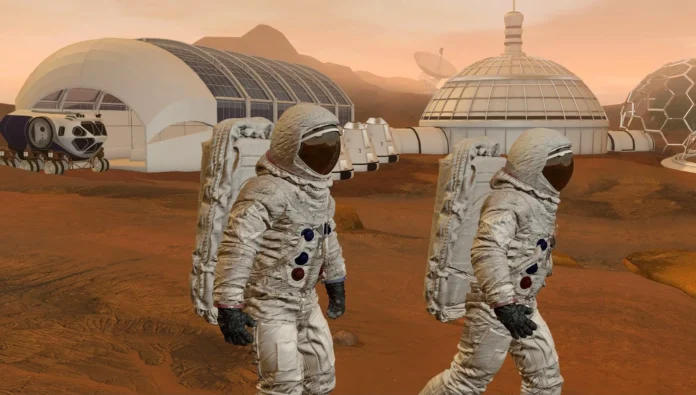Space exploration, one of humanity’s most remarkable achievements, has led to significant advancements in technology and scientific knowledge. NASA, at the forefront of space exploration, has made significant strides by sending astronauts to the Moon and exploring other planets in our solar system. However, the future of space exploration is not limited to our own planet. In this article, we will delve into NASA’s plans for colonizing Mars and beyond, while exploring the future of space exploration.
Mars Colonization: An Elaborate and Long-Term Endeavor
As the next frontier of human space exploration, Mars is NASA’s prime focus. The space agency has spent years devising plans to send astronauts to the Red Planet and hopes to make this happen by the 2030s. However, colonizing Mars is not merely a matter of sending astronauts to the planet. It is an elaborate, complex, and long-term plan for sustainable living.
-
Getting to Mars: The Space Launch System (SLS)
The first step in colonizing Mars is to reach the planet’s surface. NASA is currently developing the Space Launch System (SLS), which is slated to be the most powerful rocket ever constructed. The SLS will be instrumental in launching the Orion spacecraft, which will carry astronauts to Mars.
-
Landing on Mars: Mars Entry, Descent, and Landing (EDL)
Once the spacecraft reaches Mars, the next challenge is landing safely on the planet’s surface. NASA is developing a new technology called Mars Entry, Descent, and Landing (EDL), which will enable a safe and controlled landing on the planet’s surface.
-
Building Habitats: Inflatable Structures and 3D-Printed Habitats
After landing on Mars, astronauts will require a suitable habitat for living and working. NASA is exploring various options for building habitats on Mars, such as inflatable structures and 3D-printed habitats. These habitats will need to shield astronauts from the harsh Martian environment, including extreme temperatures and radiation.
-
Growing Food: Hydroponic and Aeroponic Systems
A sustainable colony on Mars will also require a source of food. NASA is developing technologies to grow food on Mars, such as hydroponic and aeroponic systems. These systems will need to provide enough food for the entire colony while withstanding the harsh Martian environment.
-
Generating Energy: Solar and Nuclear Power
A colony on Mars will also need a source of energy. NASA is exploring various options for generating energy on Mars, such as solar power and nuclear power. These systems will need to provide sufficient energy for the entire colony while withstanding the harsh Martian environment.
-
Conducting Research: A Wide Range of Scientific Experiments
Lastly, a colony on Mars will require continual scientific research. NASA plans to conduct a wide range of scientific experiments on Mars, including the study of the planet’s geology, atmosphere, and potential for supporting life. This research will enable a better understanding of Mars and its potential for future human habitation.
Beyond Mars: NASA’s Ambitious Plans for the Future of Space Exploration
While colonizing Mars is an exciting prospect for NASA, it is only the beginning of the space agency’s ambitious plans for the future of space exploration. NASA has several other innovative projects in the works, including:
-
Deep Space Gateway: A Space Station in Orbit around the Moon
The Deep Space Gateway is a proposed space station that will orbit around the Moon. This station will serve as a hub for deep space exploration, allowing astronauts to travel to and from the Moon, Mars, and other destinations in our solar system.
-
Europa Clipper: Exploring One of Jupiter’s Moons
Europa, one of Jupiter’s moons, is believed to have a subsurface ocean that may support life. NASA is developing the Europa Clipper mission, which will explore the moon and gather data to help us better understand its potential for supporting life.
-
New Horizons: Studying the Formation and Evolution of Our Solar System
NASA’s New Horizons mission has already provided groundbreaking insights into our solar system, including a flyby of Pluto. The mission is now heading towards the Kuiper Belt, a region of icy objects beyond Neptune, to study the formation and evolution of our solar system.
-
James Webb Space Telescope: Observing Early Galaxies and Exoplanets
The James Webb Space Telescope is the successor to the Hubble Space Telescope and will be the largest and most powerful space telescope ever built. The telescope will be able to observe some of the earliest galaxies in the universe, as well as study the atmospheres of exoplanets, potentially revealing the presence of life beyond Earth.
Challenges and Considerations: Funding, Safety, Environmental Impact, and International Collaboration
Although NASA’s plans for space exploration are exciting, they are not without their challenges and considerations. Some of these include:
-
Funding: A Costly Endeavor
Space exploration is an expensive venture, and NASA’s plans for the future of space exploration will require significant funding. It is critical for NASA to secure the necessary funding to ensure the success of these missions.
-
Safety: Ensuring the Wellbeing of Astronauts and Personnel
Space exploration is inherently dangerous, and NASA must take every precaution to ensure the safety of astronauts and other personnel involved in these missions.
-
Environmental Impact: Considering the Effects on Other Worlds
As we explore other planets and moons, it is important to consider the potential environmental impact of our activities. NASA must ensure that our exploration does not harm the natural environments of other worlds.
-
International Collaboration: A Global Effort
Space exploration is a collaborative international effort, and it is important for NASA to work with other countries and space agencies to ensure the success of these missions.
Conclusion: Advancing Our Understanding of the Cosmos
NASA’s plans for the future of space exploration are ambitious and exciting, with plans to colonize Mars and explore other planets and moons in our solar system. While there are challenges and considerations to take into account, the potential benefits of space exploration, including scientific discovery and the expansion of human knowledge, make it a worthwhile endeavor. As we continue to explore the mysteries of our universe, NASA’s efforts will continue to push the boundaries of human achievement and advance our understanding of the cosmos.
In summary, NASA’s ongoing space exploration programs and future missions aim to expand our knowledge of the universe and push the boundaries of human achievement. The agency’s focus on colonizing Mars, developing innovative technologies for sustainable living in space, and exploring other planets and moons in our solar system are exciting prospects for the future of space exploration. However, the challenges and considerations of funding, safety, environmental impact, and international collaboration must be carefully considered to ensure the success of these missions. Despite these challenges, the potential benefits of space exploration make it a worthwhile endeavor that could lead to significant scientific discoveries and advancements in human knowledge.
Google News | Telegram
















